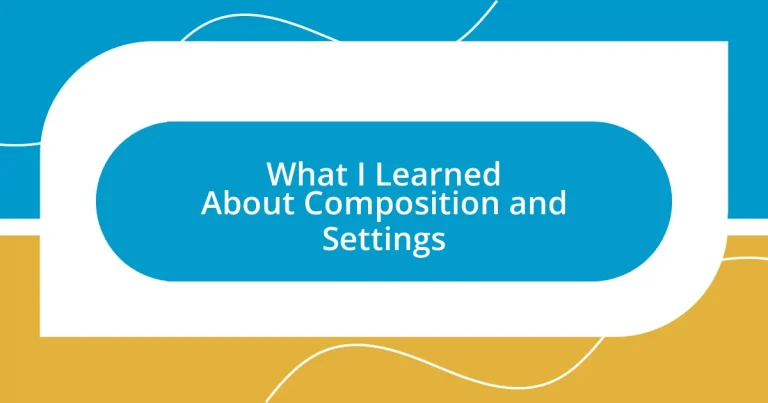Key takeaways:
- Understanding and applying the rule of thirds enhances composition, creating balance and inviting storytelling in photographs.
- Utilizing light and shadow effectively can transform ordinary scenes, adding depth, emotion, and narrative elements to imagery.
- Incorporating foreground elements and breaking traditional composition rules can foster a deeper connection and more dynamic expression in photography.
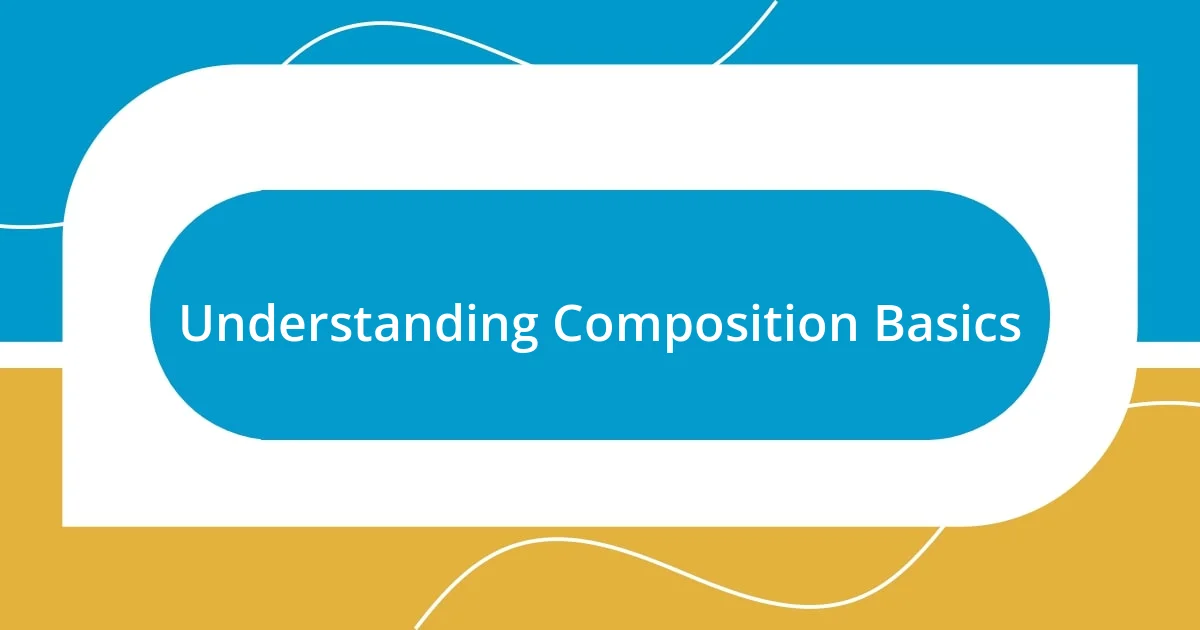
Understanding Composition Basics
When I first started exploring photography, one of the most eye-opening lessons was understanding the rule of thirds. This simple technique involves dividing your frame into nine equal sections by two horizontal and two vertical lines, and placing the most important subjects along these lines or their intersections. I remember feeling a rush of excitement as I applied this rule to my landscape shots; suddenly, my images began to feel more balanced and dynamic.
Another essential aspect of composition is leading lines. I’ve noticed how they naturally draw the viewer’s eye into the photograph, creating an inviting pathway to the subject. Just the other day, while taking a walk, I spotted a winding road framed by trees, leading the viewer toward a distant mountain. I couldn’t help but think—what story does this path tell, and how can I capture that essence in a single frame?
Finally, don’t underestimate the power of negative space. When I intentionally left some areas of my images empty, it felt like I was giving the subject room to breathe. I often ponder—how can space enhance a feeling of isolation or freedom in my work? Each time I play with this idea, I’m reminded of the emotional depth that thoughtful composition can convey.
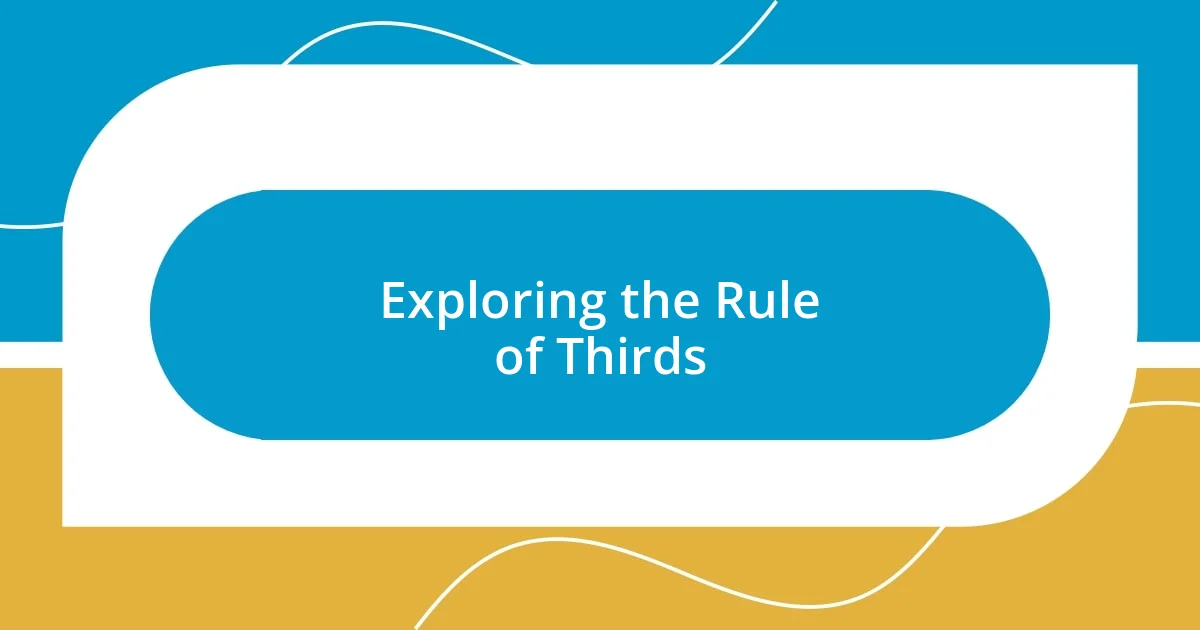
Exploring the Rule of Thirds
When I first started practicing the rule of thirds, it felt like I was given a secret key to unlock more captivating images. I vividly remember standing in my garden and experimenting with this technique. I framed a vibrant flower, placing it at the intersection of the lines, and the resulting photograph had a level of interest that my earlier shots lacked. It’s fascinating how such a simple guideline can transform our perception and enhance the storytelling aspect of a photo.
While capturing my dog playing in the park, I discovered how the rule of thirds could evoke emotion and movement. Instead of centering him in the frame, I positioned him off to the side, allowing space for the grassy field he was racing through. It was as if that open space told a story of freedom and joy, enhancing the viewer’s experience. In moments like this, I often ponder how minor adjustments can shift the entire tone of an image.
As I’ve grown more comfortable with this technique, I’ve realized how it can guide not just the arrangement of elements in a photo, but also my emotional journey behind the lens. Each time I purposefully align my subjects along those lines, I feel a thrill of creativity, as if I’m partaking in a visual dance with my surroundings. This dynamic approach not only elevates my work but also deepens my connection to the art of photography itself.
| Centered Composition | Rule of Thirds |
|---|---|
| Subject is placed in the center. | Subject is positioned along intersecting lines. |
| Can feel static or uninteresting. | Creates balance and dynamism in the image. |
| Less room for negative space. | Encourages exploration of negative space. |
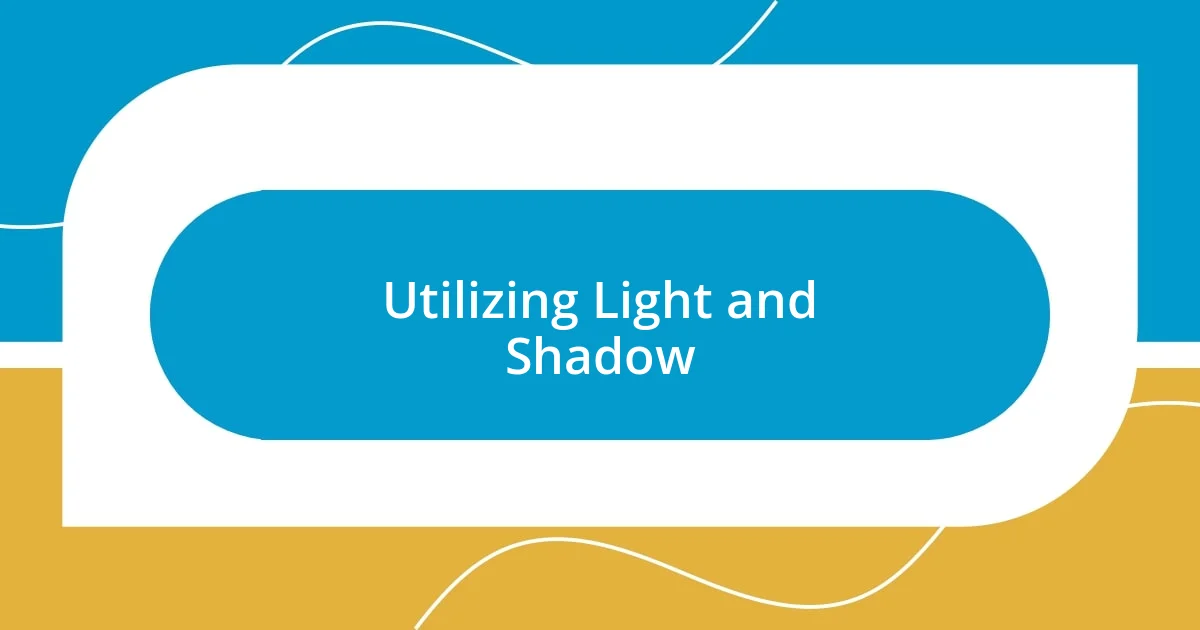
Utilizing Light and Shadow
Light and shadow are two of the most powerful tools in photography. I’ll never forget the first time I captured the golden hour—the soft, warm light enveloped everything around me, transforming a mundane scene into something ethereal. The shadows danced, revealing textures and depth that I hadn’t noticed before. It was a defining moment that showed me how light can set a mood and evoke emotions in my images.
- Hard light: Produces strong shadows that can create drama and contrast, ideal for showcasing textures.
- Soft light: Gently diffused light, like during golden hour, offers a flattering, dreamy quality that’s perfect for portraits.
- Backlighting: Placing the light source behind your subject highlights outlines and creates a beautiful halo effect.
- Shadow play: Experimenting with shadows can add an element of mystery and intrigue, often leading the viewer to ponder what lies beyond.
On another occasion, while exploring an old abandoned building, I was struck by how the interplay of light streaming through broken windows cast intricate patterns on the floor. I felt a rush of creativity as I positioned my camera to capture not just the light but also the shadows that hinted at the building’s forgotten past. It was a reminder that every scene has its own story, and it often takes just the right mix of light and shadow to tell it.

Creating Depth in Your Work
Creating depth in your work is an exploration of layers, both visually and emotionally. I remember one chilly afternoon when I captured a serene landscape—there was a mesmerizing tree silhouetted against a pastel sky. By using foreground elements like tall grasses, I drew the viewer’s eye through the image, inviting them to journey deeper into the scene. It was a humbling realization: depth isn’t just about what’s in focus, but about how elements relate to one another. How might you enhance your compositions using similar techniques?
In another instance, I found myself photographing a bustling market. I framed my shot to include both the vibrant stalls and the distant crowd, creating a sense of space and layering that told a richer story. It was as if I could almost hear the market’s lively chatter through the image. These moments remind me that depth gives context to our subjects, allowing viewers to feel the atmosphere and energy of a scene. Doesn’t that make you want to think more about how you frame your shots?
Focusing on depth also invites me to reconsider my relationship with the subjects I photograph. While I was capturing a beloved family gathering, I sought not just the faces but the environment—wide shots that included the décor and the lively interactions created a visual narrative. Each layer added emotion, transforming a simple moment into a tapestry of connection. It’s fascinating how these additional elements can amplify the story we wish to tell. What stories is your work waiting to unveil?

Choosing Effective Color Schemes
Choosing the right color scheme can elevate your photographs in ways you might not expect. I recall my early days of experimentation when I stumbled upon the mesmerizing effect of complementary colors. A sunset shot where the oranges of the fading sun contrasted beautifully with the cool blues of the water made my heart race. It was as if the image came alive, pulling the viewer’s emotions in different directions. Have you ever wondered how certain colors make you feel differently inside? That’s the magic of effective color choices.
In my journey, I’ve also embraced monochromatic schemes, often finding solace in their simplicity. I captured a misty morning scene, where soft grays and muted blues portrayed a sense of calm and introspection. It made me realize that sometimes, less truly is more. The color palette can dictate the mood before a single narrative element is introduced. How do you choose colors that resonate with the story you’re telling?
I always find that experimenting with colors helps me discover new emotional depths in my work. On a spontaneous trip to a local market, I found myself captivated by the vibrant reds and greens of fresh produce. I captured a close-up, allowing the colors to sing together. The resulting image exuded energy and joy, reminding me of the lively conversations and laughter surrounding those vibrant moments. What stories do you hope to express through your color choices?

Enhancing Settings Through Detail
When it comes to enhancing settings through detail, I often think about the textures that bring a scene to life. One afternoon, while wandering through an abandoned barn, I stopped to capture a photograph of the weathered wood and rusted tools. The peeling paint told an unspoken story of time and neglect, invoking a deep sense of nostalgia. I realized that these small details can transport viewers, allowing them to visualize not just the scene, but the emotions tied to it. Have you ever considered how textures influence your connection to an image?
I also find that incorporating sensory details can amplify the narrative within a setting. During a hike in a lush forest, I took a moment to photograph the dew-laden leaves and sun-dappled ground. The fresh, earthy scent and the sounds of rustling leaves surrounded me, creating a sensory experience that transcended mere visuals. I wanted to share that feeling, so I focused on details that would evoke those sensations for my audience. How do you capture not just what you see, but what you feel in a setting?
There’s an undeniable power in the interplay of light and shadow that can enhance the atmosphere of a scene. I remember a golden hour shoot at an old stone wall where sunlight streamed through the gaps, casting intricate shadows. By highlighting these details, I added a layer of drama that turned an ordinary setting into something captivating. The way light embraced the edges of objects can transform a simple backdrop into a canvas of emotions. Are you paying enough attention to how light shapes your photographs, creating moods and inviting stories?
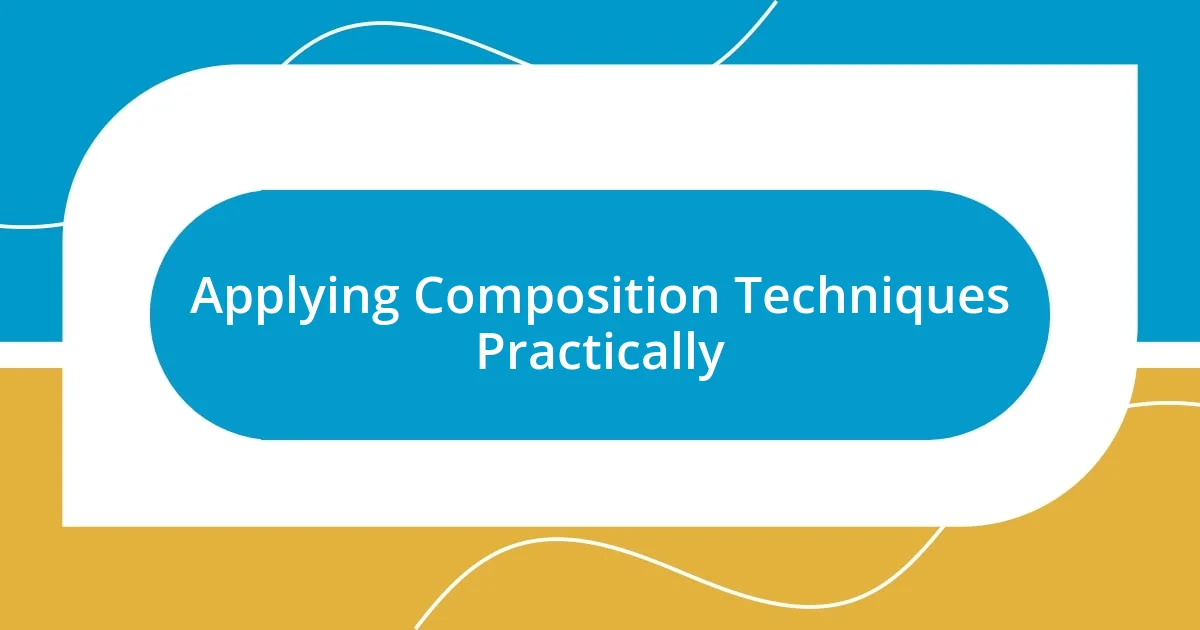
Applying Composition Techniques Practically
Capturing composition techniques in practical settings is all about intentionality. I remember a time when I was photographing a bustling street market. By applying the rule of thirds, I framed my main subject—an elderly vendor—off to the side. This choice not only drew attention to her vibrant produce stall but also allowed the blurred motion of the busy background to tell a rich story. Have you ever taken a moment to consider how positioning can influence the story your image narrates?
Another technique I often explore is leading lines, which guide the viewer’s eyes through the frame. One afternoon, while at a seaside pier, I spotted the wooden planks creating a natural pathway toward the horizon. I positioned myself at an angle that emphasized this line, creating a sense of depth and inviting the viewer on an emotional journey. It made me realize how leading lines can elevate a composition from ordinary to extraordinary. Have you considered how your scenes might benefit from the pathways your viewers can follow?
I’ve found that breaking the rules can sometimes yield the most authentic expressions in photography. On a recent photography excursion, I experimented with cropping tightly around a group of friends laughing together at a picnic. By eliminating extraneous details, I focused solely on their joyful expressions, encapsulating a moment rich with emotion and vibrancy. This spontaneous approach reminded me that sometimes it’s the unplanned decisions that resonate most deeply with the viewer. What unconventional choices have you made that transformed your shots into something unexpected?












